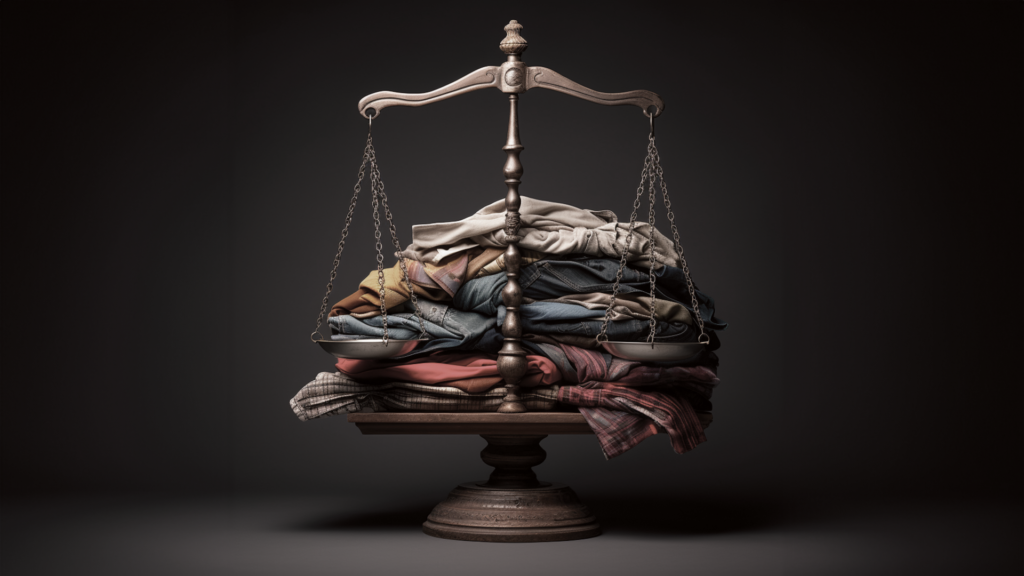IP LAW
APPLIES TO
PHYSICAL AND DIGITAL
FASHION
GOODS
Why the Metaverse Creates Brand Identity and Authenticity Issues for Fashion Companies
Have you ever scrolled through eBay, StockX, Facebook Marketplace, or some other secondary marketplace and come across a pair of sneakers that catches your eye? Maybe there’s that luxury handbag that is normally outside your budget but a seller is selling the item for a significantly cheaper price. You pull the trigger and make the purchase, only to wait a week for the item to arrive and realize that the product was not truthfully advertised. In fact, upon further inspection, you realize that you bought a “dupe” – a fake.
The Battle Against Counterfeit Goods in Secondary Marketplaces is Significant
This is the unfortunate reality of secondary marketplaces. Some sellers will blatantly sell fake versions of real fashion products under the façade of the product being genuine. A 2018 study by the US Government Accountability Office found that about 40% of goods purchased on e-commerce websites are counterfeit products. This same study also determined that of the 32 million shipments processed by US Customs and Border Protection (USCBP) in the year 2016, over 31,000 of them were seized containing products that infringed on the copyright, trademarks, or other IP rights belonging to major brands, including fashion-oriented brands. The estimated value of these seizures was over $1.3 billion. That’s nearly 3 times the valuation of the top 10 luxury fashion brands in 2023.
The sale of counterfeit goods has been a battle USCBP has consistently engaged in for years. USCBP recognizes the transport and sale of counterfeit goods as a federal offense that is punishable by a fine, prison time, or both if one is convicted of engaging in criminal copyright infringement or criminal trademark infringement. But aside from government intervention and enforcement, secondary marketplaces have come to recognize the growing trend of counterfeit goods sales on their platform. Thankfully, they have addressed this issue front and center. In addition to having a counterfeit goods policy, eBay has created authentication protocols that would ensure that any watch, handbag, or piece of jewelry sold is authenticated by a professional. Similarly, StockX (a marketplace known for selling sneakers) has its own verification process to ensure that any sneaker sold is legitimate.
The biggest victims of counterfeit goods sales on secondary marketplaces are brands. In particular, fashion brands have been prone to infringement-worthy activity for decades. Behavior like this is well documented in “House of Gucci” when counterfeit Gucci products were being sold for a significant fraction of the cost during Gucci’s meteoric rise to fame. Fashion brands recognize that people are quick to flock to secondary marketplaces or even take a walk to places like Canal Street and get a fake product and compromise quality for the sake of saving money.
New Media = New Opportunities for Infringement Activity
The culture of counterfeit fashion product sales has taken a new turn in recent years, as the budding NFT marketplace has become the new home of alleged “dupe” product sales. Many recent headlines have brought this matter to the forefront. Last year, Nike accused StockX of trademark infringement after StockX sold NFTs of sneakers to consumers who had purchased the same sneaker on their website. In the same allegation, Nike accused StockX of selling counterfeit Nike sneakers that were verified to be authentic. As significant as this Nike/StockX lawsuit is, it pales in comparison to a recent lawsuit involving the iconic Birkin bag.
When you think of Hermes, one of the most powerful and dynamic high fashion brands in the world, you think of its most popular and recognizable product: the Birkin bag. The price tag ranges anywhere between $10,000 and $40,000, with even diamond-covered Birkin selling at a robust $2 million.
But what if you could buy a Birkin (well, maybe not a real one) for an extreme fraction of the cost? Enter stage left, MetaBirkins. MetaBirkins was conceived by artist Mason Rothschild in late 2021 during the NFT (non-fungible token) boom. The appeal of MetaBirkin NFTs is that they weren’t as expensive as actual Birkin bags. Priced at $450, these digital collectibles closely mimicked the Birkin’s design and generated a reported $450,000 in sales. However, Rothschild unknowingly violated Hermes' trademark and trade dress.
In January 2022, Hermes pursued a trademark and trade dress infringement lawsuit against Mason Rothschild. In their lawsuit, they alleged that Mason Rothschild’s use of the word “Birkin” violated the trademark rights to the Birkin name that is registered in the US Patent and Trademark Office. They also alleged that Mason Rothschild’s recreation of the Birkin bag in NFT form infringed on the trade dress of the Birkin bag that is also registered in the USPTO. According to the argument set forth by Hermes, Mason Rothschild’s use of the Birkin name and his recreation of the Birkin bag is enough to cause consumer confusion.
Consumer confusion is a core element in trademark infringement lawsuits because it boils down to whether an infringer’s use of an existing trademark could lead people to believe that the infringement came from the original trademark owner. Here, Hermes provided actual data showing consumer confusion, especially because it was around the time that other fashion brands were jumping on the NFT bandwagon. Also, while MetaBirkins were considerably cheaper than an actual Birkin bag, it definitely was an expensive NFT, which seemed to be congruent to Birkin’s typically high price tag.
Mason Rothschild, on the other hand, argued that MetaBirkins was not trademark infringement but rather an exercise of free expression that is afforded to him as an artist under the 1st Amendment. In trademark infringement matters, a defendant can raise a 1st Amendment defense that came about thanks to the iconic Rogers v. Grimaldi decision. Rogers v. Grimaldi determined that an alleged infringer is not liable for trademark infringement if their use of someone else’s trademark was used in creative works of expression. Mason Rothschild argued that as an artist, he was expressing his vision no different than Andy Warhol did with his Campbell’s soup can series.
Unfortunately, though, the odds were not in Mason Rothschild’s favor, as the Southern District of New York found that MetaBirkins was not subject to protection under the 1st Amendment. Mason Rothschild sought an appeal from the SDNY, asking for a new trial and a re-review of the facts of the MetaBirkins case. However, the court quickly denied the request and even permanently enjoined Rothschild from profiting off of MetaBirkins NFTs and even owning any MetaBirkins-oriented domain names. This was essentially the last nail that sealed the coffin for MetaBirkins.
HERMES V. ROTHSCHILD

TAKEAWAYS FROM THE METABIRKINS LAWSUIT
There’s a lot to unpack from the MetaBirkins case, but there are so many valuable lessons to learn from this lawsuit that fashion brands should be aware of with the evolving landscape of newer media and intellectual property law:
#1
The Law Doesn’t Discriminate Between Digital and Physical Universe
While current IP law is a bit antiquated, it’s safe to say that the language of the Lanham Act (federal law governing trademarks), the Copyright Act of 1976, and other IP legislation is broad enough to cover existing media and media that are to come in the future. And yet, with the dawn of NFTs, the metaverse, generative artificial intelligence, and other newer media, people fail to understand that intellectual property law governs the digital universe as much as it governs the physical universe.
#2
Brands need to protect their IP
While current IP law is a bit antiquated, it’s safe to say that the language of the Lanham Act (federal law governing trademarks), the Copyright Act of 1976, and other IP legislation is broad enough to cover existing media and media that are to come in the future. And yet, with the dawn of NFTs, the metaverse, generative artificial intelligence, and other newer media, people fail to understand that intellectual property law governs the digital universe as much as it governs the physical universe.
#3
NFTs are a new breeding ground for infringements
Perhaps the biggest lesson to be learned is newer media like NFTs and the metaverse are highly unregulated. Existing law contains broad enough catch-all phrasing that could apply to them. The reality though is that NFTs and the metaverse are still the wild west. NFT creators are mindlessly using other people’s trademarks without thinking of the big-picture issues. In the same vein, brands have their hands full trying to inhibit infringements of their IP in real life and these alternative universes.
The MetaBirkins case scratches the surface of the abundant number of legal issues facing major brands who are seeking to protect their IP from infringements in these emerging technology ecosystems. Fashion brands must remain proactive in registering their trademarks, registering design patents, and continuously protecting other aspects of their IP portfolio in such a way that they have full latitude to go after anyone who infringes on their products.
For many fashion brands, their legal battles are no longer limited to going after the manufacturers of counterfeit goods, whether the product is sold on eBay, DHGate, or elsewhere. With the dawn of NFTs and new media, infringements like the ones evidenced in the MetaBirkins case are very likely to happen. Fashion brands must recognize that battling “dupe” product culture has reached new dimensions; if they’ve combatted counterfeit culture all these years, addressing it in new terrain like the metaverse should be straightforward.
Do you agree with this?
Do you disagree or have a completely different perspective?
We’d love to know

